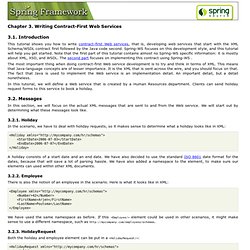

JAXB Custom Binding - Java.util.Date / Spring 3 Serialization. Chapter 3. Writing Contract-First Web Services. Chapter 3.

Writing Contract-First Web Services This tutorial shows you how to write contract-first Web services, that is, developing web services that start with the XML Schema/WSDL contract first followed by the Java code second. Spring-WS focuses on this development style, and this tutorial will help you get started. Note that the first part of this tutorial contains almost no Spring-WS specific information: it is mostly about XML, XSD, and WSDL. The second part focuses on implementing this contract using Spring-WS . The most important thing when doing contract-first Web service development is to try and think in terms of XML. In this tutorial, we will define a Web service that is created by a Human Resources department. In this section, we will focus on the actual XML messages that are sent to and from the Web service. In the scenario, we have to deal with holiday requests, so it makes sense to determine what a holiday looks like in XML: <Holiday xmlns=" <Employee xmlns="
Spring Web Services - Reference Documentation. Spring-ws-reference.pdf (application/pdf Object) WSDL Essentials. Web Services. How to Use Spring Web Services. We Recommend These Resources Spring Webservices encourages a contract first, message oriented approach to creating Webservices.

The underlying details are completely under developer control starting from the contract to the marshalling/unmarshalling details to the endpoint handling the request. Let us start by an example of a simple service to expose as a webservice - call it the MemberService. MemberService exposes one operation “Get Member Details” which returns the details of a member/person, given an identifier. Creating the contract: The Contract/WSDL for this service is fairly simple.
Building a web service with Spring-WS. [WCF client for a Spring Webservice: An interoperabilty story. Part 2.] There is an abundance of web service frameworks in Java. Apache Axis(1&2), Apache CXF, XFire, Metro (from the Java family itself),.. the list goes on. All are rich in features. It is not an easy job to select the right one always. Our selection of Spring Web Services(Spring-WS) was based on few compelling reasons. First and foremost reason was its coverage. Figure 2.1. Now we need to publish OrderService as a web service. When building web services, generally there are two different approaches considered – Contract First(WSDL/XSD first) and Contract Last(Java first). So, in our implementation, we start with an XML Schema(XSD), as our contract. Now let us look at the steps involved in building the service. Let us use our favorite Eclipse IDE for Java EE Developers. Now let us follow these steps.